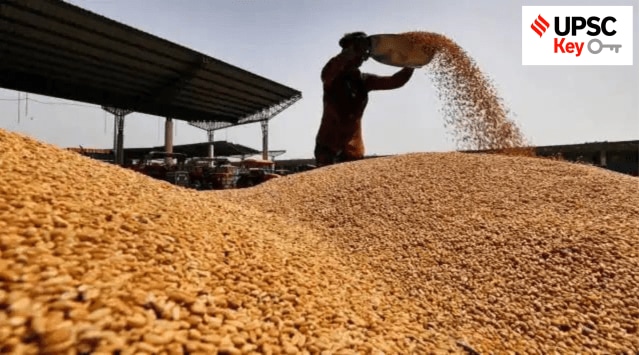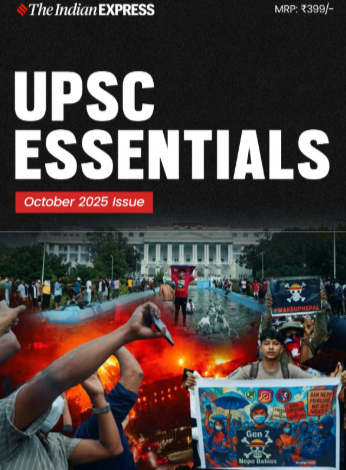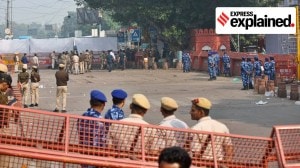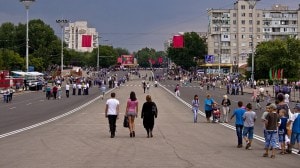Priya Kumari Shukla is a Senior Copy Editor in the Indian Express (digital). She contributes to the UPSC Section of Indian Express (digital) and started niche initiatives such as UPSC Key, UPSC Ethics Simplified, and The 360° UPSC Debate. The UPSC Key aims to assist students and aspirants in their preparation for the Civil Services and other competitive examinations. It provides valuable guidance on effective strategies for reading and comprehending newspaper content. The 360° UPSC Debate tackles a topic from all perspectives after sorting through various publications. The chosen framework for the discussion is structured in a manner that encompasses both the arguments in favour and against the topic, ensuring comprehensive coverage of many perspectives. Prior to her involvement with the Indian Express, she had affiliations with a non-governmental organisation (NGO) as well as several coaching and edutech enterprises. In her prior professional experience, she was responsible for creating and refining material in various domains, including article composition and voiceover video production. She has written in-house books on many subjects, including modern India, ancient Indian history, internal security, international relations, and the Indian economy. She has more than eight years of expertise in the field of content writing. Priya holds a Master's degree in Electronic Science from the University of Pune as well as an Executive Programme in Public Policy and Management (EPPPM) from the esteemed Indian Institute of Management Calcutta, widely recognised as one of the most prestigious business schools in India. She is also an alumni of Jamia Milia Islamia University Residential Coaching Academy (RCA). Priya has made diligent efforts to engage in research endeavours, acquiring the necessary skills to effectively examine and synthesise facts and empirical evidence prior to presenting their perspective. Priya demonstrates a strong passion for reading, particularly in the genres of classical Hindi, English, Maithili, and Marathi novels and novellas. Additionally, she possessed the distinction of being a cricket player at the national level. Qualification, Degrees / other achievements: Master's degree in Electronic Science from University of Pune and Executive Programme in Public Policy and Management (EPPPM) from Indian Institute of Management Calcutta ... Read More
UPSC Key—29 August, 2023: Minimum Support Price, Hindenburg Research, Rozgar Mela and Amitabh Kant committee
Exclusive for Subscribers from Monday to Friday: Have you ever thought about how Agreement on Agriculture, Kharif and Rabi Crops are relevant to the UPSC Exam? What significance do topics like corporate governance, Real Estate (Regulation and Development) Act, 2016 and Western concept of secularism have for both the preliminary and main exams? You can learn more by reading the Indian Express UPSC Key for August 29, 2023.
 UPSC Key August 2023: Here's what you should be reading from the August 29, 2023 edition of The Indian Express
UPSC Key August 2023: Here's what you should be reading from the August 29, 2023 edition of The Indian Express Important topics and their relevance in UPSC CSE exam for August 29, 2023. If you missed the August 28, 2023 UPSC CSE exam key from the Indian Express, read it here
FRONT PAGE
Citing inflation and WTO subsidy limit, NITI, Commerce red-flagged MSP hike
Syllabus:
Preliminary Examination: Economic and Social Development
Main Examination: General Studies III: Issues related to direct and indirect farm subsidies and minimum support prices
Key Points to Ponder:
• What’s the ongoing story-From concerns on inflation to advice on meeting WTO obligations and suggestions to address labour shortages and rising wages, key Central government ministries and departments had conveyed apprehensions to the Union Ministry of Agriculture and Farmers’ Welfare on its proposal to hike the minimum support price (MSP) for kharif crops in the 2023-24 season.
• What were the recommendations of the Commission for Agricultural Cost & Prices (CACP)?
• Quick Recall-On June 7, the Cabinet chaired by Prime Minister Narendra Modi approved the increase in MSP ranging from 6 per cent to 10 per cent. The government had said the increase was in line with the Union Budget 2018-19 announcement of fixing MSP at a level of at least 1.5 times the cost of production, aimed at reasonably fair remuneration for farmers.
In response to the Agriculture Ministry’s note, Niti Aayog, the Centre’s think tank, wrote that “this much” of an increase in MSP would make it difficult to keep inflation in check. “The increase suggested in MSP varies from 5.3 per cent in case of urad to more than 10 per cent in crops like cotton (long staple), sesamum and moong. If this much increase is given to MSP, it will be very difficult to keep food inflation in the stipulated range of 4-6 per cent, which is very important for macro-economic stability,” NITI Aayog wrote in a letter dated May 16.
• Why labour shortage and rising wages are key concerns in Indian agriculture at present?
• The Department of Commerce highlighted the need to adhere to the World Trade Organization’s clause that subsidies should not go beyond the prescribed limit-What is the prescribed limit given by WTO?
• What Agreement on Agriculture under WTO?
• Overall, what are the issues and challenges with the hike of MSP?
• Kharif and Rabi Crops-Compare and Contrast
• MSP (minimum support price) and effectiveness of MSP implementation-discuss
• Which are the Crops Covered under MSP?
• How MSP is calculated (paid out costs, labour etc.) and Crops covered under the MSP
• The Commission for Agricultural Costs & Prices (CACP)-Know in Detail
• The Commission for Agricultural Costs & Prices (CACP) and Minimum support prices (MSP)-Connect the dots
• How Government fix MSPs of crops before every planting season?
• What are the demands by Farmers in the context of MSP in the recent scenario?
• “Right to MSP”-is it possible to implement and if not, then what are the issues and Challenges?
• Kharif, Rabi crops, MSP and Doubling Farmers Income-How they are interconnected?
• Recommendation of Ashok Dalwai Committee and M. S. Swaminathan Committee on MSP-Key highlights
• What do you understand by the term ‘comprehensive cost of production of a crop’?
• Demand for legal guarantee for MSP-Pros and Cons
Other Important Articles Covering the same topic:
📍Explained: What is minimum support price (MSP), and how is it fixed?
📍Explained: MSP and govt panel’s task
📍MSP hike by 5-10% on Kharif crops did not alone move the needle on inflation
Previous year UPSC Prelims Question Covering similar theme:
📍Which of the following factors/policies were affecting the price of rice in India in the recent past? (UPSC GS1, 2020)
(1) Minimum Support Price
(2) Government’s trading
(3) Government’s stockpiling
(4) Consumer subsidies
Select the correct answer using the code given below:
(a) 1, 2 and 4 only
(b) 1, 3 and 4 only
(c) 2 and 3 only
(d) 1, 2, 3 and 4
📍In India, which of the following can be considered as public investment in agriculture? (UPSC GS1, 2020)
(1) Fixing Minimum Support Price for agricultural produce of all crops
(2) Computerization of Primary Agricultural Credit Societies
(3) Social Capital development
(4) Free electricity supply to farmers
(5) Waiver of agricultural loans by the banking system
(6) Setting up of cold storage facilities by the governments.
In India, which of the following can be considered as public investment in agriculture?
Select the correct answer using the code given below:
(a) 1, 2 and 5 only
(b) 1, 3, 4 and 5 only
(c) 2, 3 and 6 only
(d) 1, 2, 3, 4, 5 and 6
📍The Fair and Remunerative Price (FRP) of sugarcane is approved by the (UPSC GS1, 2015)
(a) Cabinet Committee on Economic Affairs
(b) Commission for Agricultural Costs and Prices
(c) Directorate of Marketing and Inspection, Ministry of Agriculture
(d) Agricultural Produce Market Committee
Short selling in Adani shares led to ‘gains’ for 12 firms: ED to Sebi
Syllabus:
Preliminary Examination: Current events of national and international importance
Main Examination: General Studies IV: corporate governance
Key Points to Ponder:
• What’s the ongoing story-The Enforcement Directorate has concluded, after a preliminary investigation into the Hindenburg Research report and the subsequent market crash, that a dozen companies including foreign portfolio investors and foreign institutional investors (FPIs/ FIIs) based in tax havens were the “top beneficiaries” of short selling in shares of Adani Group companies, The Indian Express has learnt.
• Who is called short seller?
• What is short selling of shares?
• For Your Information-“Buy low, sell high” is the traditional investment strategy in which one buys a stock or security at a particular price and then sells it when the price is higher, thereby booking a profit. This is referred to as a “long position”, and is based on the view that the price of the stock or security will appreciate with time.
Short selling, or shorting, on the other hand, is a trading strategy based on the expectation that the price of the security will fall. While fundamentally it is based on the “buy low, sell high” approach, the sequence of transactions is reversed in short selling — to sell high first and buy low later. Also, in short selling, the trader usually does not own the securities he sells, but merely borrows them.
In the stock market, traders usually short stocks by selling shares they have borrowed from others through brokerages. When the price of the shares falls to the expected levels, the trader would purchase the shares at the lower price and return them to the owner, booking a profit in the process. If, however, the price of the shares appreciates instead of falling, the trader will be forced to buy shares at a higher price to return to the owner, thereby booking a loss.
• What specific findings were uncovered by the investigation conducted by the ED?
• What is Hindenburg Research?
• What does Hindenburg Research say about the Adani Group?
• For Your Information-Hindenburg Research says on its website that the company specialises in forensic financial research. It says it has decades of experience in the investment management industry, “with a historical focus on equity, credit, and derivatives analysis”.
The company says it believes that “the most impactful research results from uncovering hard-to-find information from atypical sources”, and that it especially looks for “accounting irregularities; bad actors in management or key service provider roles; undisclosed related-party transactions; illegal/ unethical business or financial reporting practices; and undisclosed regulatory, product, or financial issues” in companies.
Hindenburg Research LLC was founded by Nathan (Nate) Anderson, 38, who studied international business management at the University of Connecticut and lived in Jerusalem before returning to the United States where he took a consulting job with a financial software company called FactSet and then at broker dealer firms in Washington DC and New York, according to a profile of the man published in the Financial Times in June 2021.
The company’s name comes from the Hindenburg disaster of 1937, an accident in which a German passenger airship caught fire and was destroyed, killing 35 people. Says the website: “We view the Hindenburg as the epitome of a totally man-made, totally avoidable disaster. Almost 100 people were loaded onto a balloon filled with the most flammable element in the universe (hydrogen). This was despite dozens of earlier hydrogen-based aircraft meeting with similar fates. Nonetheless, the operators of the Hindenburg forged ahead, adopting the oft-cited Wall Street maxim of “this time is different”.
• What is SEBI’s role in Adani-Hindenburg episode?
• Adani issue and its impact on India’s capital market-connect the dots
• Do you think that India is a capitalist economy?
• First of all, what is capitalist economy?
• How capitalist economy is different from Mixed Economy and Socialist Economy?
• Is there a government-business nexus in the evolution of capitalism?
Other Important Articles Covering the same topic:
📍Adani-Hindenburg issue: What does the Supreme Court-appointed panel’s report say?
📍What is Hindenburg Research, the company that has accused Adani Group of stock manipulation, fraud?
GOVT & POLITICS
51,000 ‘Amrit Rakshaks’ get job letters at Rozgar Mela
Syllabus:
Preliminary Examination: Indian Polity and Governance-Constitution, Political System, Panchayati Raj, Public Policy, Rights Issues, etc.
Main Examination: General Studies II: Government policies and interventions for development in various sectors and issues arising out of their design and implementation.
Key Points to Ponder:
• What’s the ongoing story- Distributing over 51,000 appointment letters via video conferencing to newly inducted recruits as part of the Rozgar Mela, Prime Minister Narendra Modi Monday said the Indian economy was on the path of rapid growth which has created big opportunities for employment of the youth. The new recruits, selected from across the country, will be joining various posts such as constable, sub-inspector and non–general duty cadre positions under the Ministry of Home Affairs (MHA).
• What is Rozgar Mela?
• What is the purpose of Rozgar Mela?
• Who organises Rozgar Melas across the nation?
• What is Karamyogi Prarambh Module?
• For Your Information- According to the Ministry of Skill Development And Entrepreneurship’s official website, Rozgaar mela is to give impetus to the employment initiatives in the country, National Skill Development Corporation (NSDC) under the aegis of Ministry of Skill Development & Entrepreneurship (MSDE), Govt. of India has been organizing Rozgar Melas across the nation for providing suitable job opportunities in private sector to the unemployed youth. With initiatives like Rozgar Melas, the Government is ensuring a parallel growth in the private/ industrial sector. There is no end to the potential for industry to flourish across the States with big corporates partnering the government and pledging to invest. A NSDC Rozgar Mela is a 1/2-day event where several employers and job seekers come together for the purpose of applying and interviewing for jobs. Defined more precisely, a Rozgar Mela is an employment strategy to fast-track the meeting of job seekers and employers. For the execution of Rozgar Melas, NSDC seeks support from the respective Sector Skill Councils (SSCs) & Pradhan Mantri Kaushal Kendras (PMKKs) for sourcing the employers i.e. private companies for the Rozgar Mela. Generally, a Rozgar Mela witnesses the participation on an average of 40-50 employers from 10-12 high economic growth sectors. These sectors are generally identified based on the aspiration of youth & availability of industries in the target State or the nearby areas.
• Do you think that these rozgar melas solve India’s unemployment crisis?
• Is unemployment an old problem or a new crisis?
• Do You Know-Just before the 2019 general election, it was reported that the official survey for unemployment (Periodic Labour Force Survey) for 2017-18 showed that unemployment had hit a 45-year high. The government rubbished the PLFS findings and continued to refute them until it was reelected. After reelection in 2019, it accepted the PLFS findings. Soon, academics found that between 2012 and 2018, the total employment fell for the first time in India’s history — by as much as 9 million (or 90 lakhs) in 6 years. Worse, it was found that not only had youth unemployment shot up starkly but also that it rose with education attainment.
In early 2020, India, like the rest of the world was hit by the Covid pandemic and predictably this worsened unemployment further. Since then we have repeatedly explained why rising unemployment, not GDP growth, is the biggest challenge for India.
• Rozgar Mela-Will they solve the unemployment crisis?
• For Your Information-According to Udit Mishra, the total jobs in question are akin to a drop in the ocean. Even if all 10 lakh vacancies are filled, they are nothing in comparison to the total estimated jobs that India needs to create. According to Radhicka Kapoor, senior visiting fellow at the Indian Council for Research on International Economic Relations (ICRIER), India needs to create anywhere between 20 million (2 crore) to 200 million (20 crore) new jobs—Because these are pre-existing vacancies, not new job creation—Because the size of public employment ( read all types of government jobs) in India was already quite low. According to a 2019 calculation by academics C. P. Chandrasekhar and Jayati Ghosh, public employees per 1000 population in India (16) was starkly lower than comparable economies such as China (57), United States (87), Brazil (111), and far lower than some of the nordic countries such as Norway (159) and Sweden (138). Some argue that people are making too much of unemployment and that India always had widespread unemployment. Others argue that the unemployment was never this high and that the current crisis has taken shape over the past decade or so.
• What explains the lack of fast job creation in the recent past?
• What is the solution to India’s unemployment woes?
Other Important Articles Covering the same topic:
📍About Rozgar Mela
📍ExplainSpeaking: Will Rozgar Mela solve India’s unemployment crisis?
THE EDITORIAL PAGE
Syllabus:
Preliminary Examination: Current events of national and international importance.
Mains Examination: General Studies II: Bilateral, regional and global groupings and agreements involving India and/or affecting India’s interests.
Key Points to Ponder:
• What’s the ongoing story-According to Ashok K Kantha: The 15th BRICS Summit concluded in Johannesburg last week with the membership of the grouping going from 5 to 11, after the induction of four countries from the Gulf and West Asia — Egypt, Iran, Saudi Arabia and the United Arab Emirates — as well as Ethiopia and Argentina from Africa and South America, respectively.
• There are major implications of this enlargement-what kind of implications?
• Quick Recap-The five-member BRICS invited six more countries to join the alliance on Thursday (August 24), in a move which can strengthen its claim of being a ‘voice of the Global South’ on one hand, while raising concerns about China’s increasing dominance on the other.
BRICS consists of Brazil, Russia, India, China, and South Africa. In its ongoing summit at Johannesburg, South Africa, it has invited Iran, the United Arab Emirates, Saudi Arabia, Argentina, Egypt, and Ethiopia. Their membership will begin in January.
• The 15th BRICS Summit and India and China meet-know the key points
• “What hogged the headlines in India was the conversation Prime Minister Narendra Modi had with President Xi Jinping of China in Johannesburg. The two sides have come out with somewhat contradictory readouts”-Know in detail
• What is the Johannesburg Declaration?
• “The ability of China, the largest economy and most influential country in the grouping, to drive the agenda and future direction of BRICS should not be underestimated”-Comment
• “India will have to guard against BRICS emerging as an anti-West grouping and as an instrument in China’s power play”-Discuss
• “The rapid expansion of members also introduces new contradictions”- What new contradictions?
• For Your Information-The rapid expansion of members also introduces new contradictions. Apart from the profound differences between India and China, we now have tensions between Iran and Saudi Arabia which are deep-rooted despite limited rapprochement. There are also fault lines between Saudi Arabia and the UAE. Besides, many of the members do not pass the test of economic vibrancy, a consideration that shaped the launch of the original BRIC platform of countries, which were expected to emerge as the dominant players in the global economy. Now the Chinese economy is slowing down and some others, including Russia, Iran, Argentina and Brazil, are going through periods of difficulty in varying degrees. Lacking internal coherence and with sluggish economies of several member countries, an expanded BRICS may just end up being more unwieldy and contentious, unless steps are taken to prevent it from becoming more political and strategic.
Other Important Articles Covering the same topic:
📍BRICS gets six new members: Significance, what it means for India
EXPRESS NETWORK
NAREDCO on Kant panel report: Agreed there’s financial stress, didn’t recommend direct support
Syllabus:
Preliminary Examination: Current events of national and international importance.
Mains Examination: General Studies II: Government policies and interventions for development in various sectors and issues arising out of their design and implementation.
Key Points to Ponder:
• What’s the ongoing story- The Amitabh Kant committee, which was tasked by the Government with suggesting ways to revive stalled real estate projects, acknowledged the financial stress of real estate developers but recommended no direct support, an industry body said.
• The Amitabh Kant committee was constituted by whom?
• And why the Committee was constituted?
• What did the committee find?
• For Your Information- The first question before the committee was how many and where are the legacy stalled projects located. In one of its five meetings with stakeholders, the committee was told by a representative of banks, the Indian Banks’ Association chief executive Sunil Mehta, that 60% of the stalled projects had already been bought, with a capital commitment of Rs.1.9 lakh crore. The committee’s report cited the IBA as estimating that 4.12 lakh dwelling units of Rs.4.08 lakh crore were “stressed” and about 2.40 lakh (44%) of these were in the National Capital Region. Another 21% of the units were in the Mumbai Metropolitan Region, it said. The committee concluded that the main reason for the stress in these projects was the “lack of financial viability”, which had led to cost overruns and time delays. The committee said the way to solve the problem would be to improve the Internal Rate of Return of the projects in order to attract funding.
Judicial interventions, like the use of the Insolvency and Bankruptcy Code, should be “the last resort”, it said. In order to make the projects viable, all stakeholders — that is the developers, financiers, land authorities etc. — would have to take a “haircut” or accept less than what is due to them, it said.
• What did the committee recommend?
• Committee recommendations-The committee began its list of recommendations by reiterating provisions of the Real Estate (Regulation and Development) Act, 2016, which mandates that all projects where the land is over 500 square metres or the number of apartments to be constructed are more than eight are registered with the respective state RERA. This, the committee said, must be “enforced”. Registration of the projects would lead to greater transparency, it said.
The committee recommended de-linking the grant of registration or sub-lease by the land authorities to the homebuyers from the recovery of dues from developers. According to the committee, about 1 lakh homebuyers would benefit from this.
Similarly, there were many projects where the homebuyers were not being given no-objection and completion certificates in projects that were substantially complete due to “administrative hurdles”. The committee recommended that the RERAs identify such projects and expedite the process to grant certificates, irrespective of the developers’ paying their dues to the authorities.
One of the main recommendations of the committee was for state governments to set up a rehabilitation package to get the stalled projects running again. Those developers who sign up for the package would have to commit to completing the projects in three years. The committee gave the example of a model package for Noida and Greater Noida that it detailed. This includes a “Zero Period” for two years starting with the onset of the COVID-19 pandemic in 2020 where interest and penalties on developers by the authorities would be waived. Developers would be allowed to get a “co-developer” on board to complete the work. The committee proposed a “partial surrender policy”, in which developers can give back some of the unused lands to the authority in exchange for a waiver on the dues for that land.
• Who will implement the recommendations?
• What is Special Window for Affordable & Mid-Income Housing (SWAMIH) Scheme?
• What is the purpose of the Real Estate (Regulation and Development) Act, 2016 (RERA Act)?
• What is the size of Real Estate market in India?
• For Your Information-According to RERA, each state and Union territory will have its own regulator and set of rules to govern the functioning of the regulator. Centre has drafted the rules for Union territories including the national Capital. While many states are still behind on schedule for notification of RERA rules, many have notified rules and a regulator will start functioning. Some of these states are Haryana, Uttar Pradesh and Maharashtra. Despite seeing a slump in the past three years, the ticket prices are relatively high and inventories are piling up. Low demand is also contributing to the reduced recovery of investment by developers. These reasons have deterred developers from reducing the ticket prices. RERA seeks to address issues like delays, price, quality of construction, title and other changes. Delays in projects are the biggest issue faced by buyers. The reasons are many and the impact is huge. Since the last 10 years, many projects have seen delays of up to 7 years. Projects launched after the turn of this decade have faced delays as well. Some have run into obstacles even before a brick was laid. The reasons include diversion of funds to other projects, changes in regulations by authorities, the environment ministry, national green tribunal etc and other bodies like those involved in infrastructure development and governing transport. In many places, land acquisition becomes an issue. Errant builders often sell projects to investors without the approval of plans, unauthorised increase in FAR, bad quality of construction, projects stuck in litigation etc.
Other Important Articles Covering the same topic:
📍What is the Real Estate Regulation Act (RERA)? Here is how it will help buyers
📍What is the Real Estate Regulation Act (RERA)? Here is how it will help buyers
Centre tells top court only it can conduct Census
Syllabus:
Preliminary Examination: Indian Polity and Governance-Constitution, Political System, Panchayati Raj, Public Policy, Rights Issues, etc.
Mains Examination: General Studies II: Welfare schemes for vulnerable sections of the population by the Centre and States and the performance of these schemes; mechanisms, laws, institutions and Bodies constituted for the protection and betterment of these vulnerable sections.
Key Points to Ponder:
• What’s the ongoing story- The Centre on Monday told the Supreme Court that the Census Act, 1948, empowers “only the Central Government” to conduct a Census. In a short affidavit filed in the Bihar caste survey matter, the Centre said, “Census is a statutory process and is governed by the Census Act, 1948. It is submitted that the subject of Census is covered in the Union List under Entry 69 in the Seventh Schedule. In exercise of the powers under the said Entry, the Central Government has made the Census Act, 1948. The said Act empowers only the Central Government to conduct Census under section 3 of the…Act…” The government said it is filing the affidavit “only with a view to place the Constitutional and legal position for consideration of this court”.
• What exactly the Centre said?
• What are the issues with Bihar caste survey?
• Quick Recap-Terming it “perfectly valid,” the Patna High Court on Tuesday (August 1) upheld the caste-based survey being conducted by the Bihar government. A bench comprising Chief Justice K Vinod Chandran and Justice Partha Sarthy dismissed the batch of petitions challenging the survey. In May, the Patna HC itself had stayed the caste survey on the grounds that the state was not competent to conduct the caste survey. In January, the Bihar government began conducting a survey of households to collect and publish data on caste with the aim of “ensuring all-round development of all sections of the State.” The second stage of the survey was to end in late May, but the survey was halted after the Patna High Court on May 4 stayed it.
Expressing concerns on the right to privacy, which has been held to be a facet of the right to life under Article 21 by the SC in its 2017 ruling in Justice KS Puttaswamy vs Union of India, the Bench had directed the state to “immediately stop the caste-based survey and ensure that the data already collected” is “secured and not shared with anybody till final orders are passed.”
The Bihar government moved the Supreme Court against the Patna HC’s decision. However, on May 18, the top court refused to stay the order, observing that the HC had kept the matter for hearing on July 3. “We will keep this pending. If the High Court does not take it up on (June) 3rd we will hear it,” the bench said. The caste survey was challenged under two significant grounds: that it violated a citizen’s fundamental right to privacy and that the state had no power to carry out such a survey.
• Why Bihar is conducting a caste census?
• What is meant by caste census?
• What is the purpose of caste census?
• What is the importance of caste census?
• Has a caste census ever been conducted?
• What data are the enumerators collecting?
• What kind of caste data is published in the Census?
• How often has the demand for a caste census been made?
• On the difference between “census” and “survey”, What exactly the Patna HC said?
• For Your Information-On the difference between “census” and “survey”, the HC said Black’s Law Dictionary “defines ‘census’ as an official count of people, made for the purpose of compiling social and economic data of the political subdivision to which the people belong”. ‘Census’ as defined by Webster’s New Collegiate Dictionary is the count of a population and a property evaluation in early Rome, which is almost a complete enumeration of the population, made by the Government. The Concise Law Dictionary by P Ramanatha Aiyar defines it as an official enumeration of the inhabitants of the state or country with details of sex, age, family, occupation, possession etc”. A “survey”, the court said, is defined in the Oxford Advanced Dictionary as “an investigation of the opinions and behaviour of a particular group of people”, determined by asking them pre-framed questions. Black’s Law Dictionary defines it as an appraisal and a general consideration of something and also includes the measuring of a tract of land. It has also been defined as a poll or questionnaire, especially one examining popular opinions, the HC said.
• What is the Socio Economic and Caste Census?
• Caste Census and Socio Economic and Caste Census-Compare and Contrast
Other Important Articles Covering the same topic:
📍Why we need the Bihar caste census
📍Explained: The caste census debate, and the government stand over the years
📍Patna HC upholds Bihar caste-based survey: Why it was challenged, what the court said
THE WORLD
France decides to ban wearing of abaya in its state-run schools
Syllabus:
Preliminary Examination: Current events of national and international importance.
Mains Examination: General Studies I: Social empowerment, communalism, regionalism & secularism.
Key Points to Ponder:
• What’s the ongoing story- France will ban school pupils attending state-run facilities from wearing the abaya, a loose-fitting, full length dress some Muslim women wear.
Education Minister Gabriel Attal, who was only promoted to his role earlier in the summer, made the announcement late on Sunday in an interview with French television channel TF1.
“When you walk into a classroom, you shouldn’t be able to identify the pupils’ religion just by looking at them,” he said.
• What prompted the move against the abaya?
• What has the reaction been?
• Question of “choice” in Educational Institutions-what’s your take?
• What is western concept of secularism?
• Indian concept of secularism and western concept of secularism-compare and contrast
• Do you think that India should follow western thought on secularism?
Other Important Articles Covering the same topic:
EXPLAINED
Syllabus:
Preliminary Examination: Current events of national and international importance.
Mains Examination: General Studies III: Achievements of Indians in science & technology; indigenization of technology and developing new technology.
Key Points to Ponder:
• What’s the ongoing story-Barely 10 days after creating history by landing near the South Pole of the Moon, the Indian Space Research Organisation (ISRO) is set to launch its spacecraft to study the Sun. Aditya-L1 will be launched on September 2 at 11:50 am from Sriharikota. The spacecraft will travel 1.5 million km from the Earth to the Lagrange 1 or L1 point between the Earth and the Sun. This distance is nearly four times that travelled by the Chandrayaan missions, but just 1% of the 150 million km between the Earth and the Sun.
• What is Aditya-L1?
• For Your Information-The Aditya-L1 mission will see the Polar Satellite Launch Vehicle (PSLV) carry the 1,475-kg spacecraft to an elliptical orbit around the Earth. The spacecraft, which will carry seven scientific payloads, is more than two times lighter than the one to the Moon. Like the Chandrayaan-3 mission, the orbit as well as the velocity of the spacecraft around the Earth will be increased till it is slingshot towards the Sun. The distance to L1 point will be covered in nearly four months. The spacecraft will then be inserted into a halo orbit around the L1 point. It will collect data for five years.
🚀PSLV-C57/🛰️Aditya-L1 Mission:
The launch of Aditya-L1,
the first space-based Indian observatory to study the Sun ☀️, is scheduled for
🗓️September 2, 2023, at
🕛11:50 Hrs. IST from Sriharikota.Citizens are invited to witness the launch from the Launch View Gallery at… pic.twitter.com/bjhM5mZNrx
— ISRO (@isro) August 28, 2023
• What is the L1 point?
• For Your Information-There are five Lagrange points, L1 to L5, between any two celestial bodies. These points can act as parking spots in space where the gravitational pull of the celestial objects equals the centripetal force required to keep a satellite in orbit. This means satellites placed at Lagrange points do not need to expend a lot of fuel to remain in position. First, going to Lagrange 1 places the spacecraft at a point beyond the Moon between the Earth and the Sun. This offers the spacecraft an unobstructed view of the Sun even during phenomena like an eclipse.
Second, with the mission covering only 1% of the distance between the Earth and Sun, the payloads will be able to look directly at the Sun. “This position will allow the main payload, VLEC, to look directly into the source of coronal mass ejection. Once at L1, it will be the best instrument observing the solar corona,” said Prof Dipankar Banerjee, director of Aryabhatta Research Institute of Observational Sciences (ARIES), which will host the support cell for the Aditya-L1 mission. Third, the L1 point makes the mission fuel-efficient.
• What are the science objectives of Aditya-L1?
• What are the payloads?
• Why study the Sun from space?
• Do You Know-According to the ISRO, the major science objectives of Aditya L1 mission are:
—Study of Solar upper atmospheric (chromosphere and corona) dynamics.
—Study of chromospheric and coronal heating, physics of the partially ionized plasma, initiation of the coronal mass ejections, and flares
—Observe the in-situ particle and plasma environment providing data for the study of particle dynamics from the Sun.
—Physics of solar corona and its heating mechanism.
—Diagnostics of the coronal and coronal loops plasma: Temperature, velocity and density.
—Development, dynamics and origin of CMEs.
—Identify the sequence of processes that occur at multiple layers (chromosphere, base and extended corona) which eventually leads to solar eruptive events.
—Magnetic field topology and magnetic field measurements in the solar corona .
—Drivers for space weather (origin, composition and dynamics of solar wind
 The spacecraft will be placed in a halo orbit around the L1, which is about 1.5 million km from the Earth. (Photo courtesy: ISRO)
The spacecraft will be placed in a halo orbit around the L1, which is about 1.5 million km from the Earth. (Photo courtesy: ISRO)
Other Important Articles Covering the same topic:
📍Rover explores lunar surface, ISRO to send Sun mission Sept 2
📍ADITYA-L1
ECONOMY
50 crore came into banking system under PMJDY: FM
Syllabus:
Preliminary Examination: Economic and Social Development-Sustainable Development, Poverty, Inclusion, Demographics, Social Sector Initiatives, etc.
Mains Examination: General Studies III: Inclusive growth and issues arising from it.
Key Points to Ponder:
• What’s the ongoing story- Finance Minister Nirmala Sitharaman on Monday said Jan Dhan Yojana-led interventions and digital transformation have revolutionised financial inclusion in the country, as more than 50 crore people have been brought into the formal banking system with cumulative deposits surpassing Rs 2 lakh crore. On the ninth anniversary of the Pradhan Mantri Jan Dhan Yojana (PMJDY), which is one of the biggest financial inclusion initiatives in the world, Sitharaman in her message said 55.5 per cent bank accounts have been opened by women, and 67 per cent have been opened in rural/semi-urban areas. Under the scheme, the number of bank accounts grew 3.4-fold from 14.72 crore in March 2015, to 50.09 crore as on August 16, 2023.
• What is Pradhan Mantri Jan Dhan Yojana?
• For Your Information-Most of the PMJDY accounts are with the public sector banks that have steered the financial inclusion drive. The number of PMJDY accounts opened by PSBs rose from 332.62 million in March 2021 to 385.89 million in May 2023, an increase of 16 per cent. The government-managed Regional Rural Banks (RRBs) have a 21 per cent increase in their PMJDY accounts to around 91 million in May 2023 from 71 million in March 2021. However, such accounts were just 14.07 million with private sector banks, up 12 per cent between March 2021 and May 2023. PMJDY was launched on 28th August 2014 to provide universal banking services by opening a zero-balance bank account for every unbanked household. The main features of the scheme include one basic savings bank deposit (BSBD) account to every unbanked adult, an overdraft (OD) limit of Rs 10,000 and a free RuPay debit card with inbuilt accident insurance cover of up to Rs 2,00,000.
• Pradhan Mantri Jan Dhan Yojana and direct benefit transfer scheme-Connect the dots
• What is Financial Inclusion?
Other Important Articles Covering the same topic:
📍Pradhan Mantri Jan Dhan Yojana (PMJDY) – National Mission for Financial Inclusion, completes nine years of successful implementation
Previous year UPSC Mains Question Covering similar theme:
📍Pradhan Mantri Jan Dhan Yojana (PMJDY) is necessary for bringing the unbanked to the institutional finance fold. Do you agree with this for financial inclusion of the poor section of the Indian society? Give arguments to justify your opinion. (UPSC GS3, 2016)
For any queries and feedback, contact priya.shukla@indianexpress.com
The Indian Express UPSC Hub is now on Telegram. Click here to join our channel and stay updated with the latest Updates.
Subscribe to our UPSC newsletter and stay updated with the news cues from the past week.
UPSC Magazine

Read UPSC Magazine





- 01
- 02
- 03
- 04
- 05



























